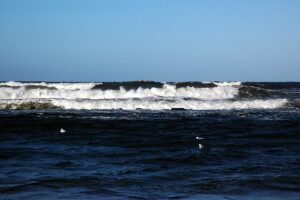In the modern world electricity is a given. In Poland to a large degree power is generated with bituminous coal and lignite. This will not change in the coming years and the deposits in, e.g. Konin (lignite -ed.) will continue to be exploited. In result, the problem with water accessibility will not disappear and the climate change we are witnessing will only make water shortages worse, especially in Greater Poland. Therefore, to the degree that it is even possible, we should start working on stopping this process, or reversing it. It seems difficult, but it is not impossible and requires changes in the way we manage water – Grzegorz Walijewski spokesman for the Institute of Meteorology and Water Management (IMGW) told BizneAlert.pl in an interview.
BiznesAlert.pl: This year’s winter was very snowy and the spring was rainy, which in theory should have improved the hydrological situation in our country. Did that actually happen?
Grzegorz Walijewski: Not necessarily. This year the winter was the first one in years, where the snowfall was average, and so was the duration of the snow cover retention. Because of this, during the end of winter and early spring the upper layer of the ground was not affected by humidity deficits. At the same time a cumulated outflow of thaw water fed into surface water during the period in question in an amounts bigger than in the previous years. This temporarily improved the hydrological situation.
Agricultural drought is in 15 out of the 16 voivodships. Does it get worse each year? What are its consequences?
One winter with average snowfall after a series of winters with little snowfall will not significantly improve the situation. Apart from that, the amount of snow in the winter is not the only requirement for soil droughts not to occur. Another one is enough rainwater, but not just from current rains. Whereas since the last big flood in 2010, the amount of rainfall across the entire country has dropped, which in case of the cumulated total constitutes a rainfall deficit equal or higher than the annual amount. This means that in the past 10 years the decrease in rainwater equals to at least an annual rainfall. In result, the upper layer of soil will continue to dry up, the upper aquifer will get lower, watercourses and surface water resources will not get enough water supply.
In Poland water is also used to cool power plants. What is the water level in Poland when it comes to this issue? Will the power industry have enough water for cooling this year?
CHP plants are stable and free of breakdowns only if they have access to enough water of the right quality. In Poland about 7 cubic kilometers (220 m3/s) a year is used to cool power plants. This is fourteen times more than the amount of water stored in the biggest reservoir in Poland in Solina. The power industry needs ten times more water than any other industry, and uses 60 percent of water in Poland’s economy.
Polish thermal power stations use so much water, because they mostly utilize a once-through flow cooling system. Only some of the plants have closed cooling systems based on cooling towers. This is a serious issue for the environment, for the following reasons:
– quality – in the open systems the water is heated up, and then released into rivers and reservoirs. This type of thermal pollution impacts the biological life in water ecosystems;
– quantity – the ever more present low water levels (related also to climate change) and flows that undermine the regular functioning of power and heat plants are dangerous to technological equipment and may lead to a complete shutdown of a facility.
So we don’t have enough water when it comes to this issue?
The fact is that Poland’s hydropower resources are small in relation to the societal and economic demand for heat and power. In theory the energy potential of our rivers is about 23 TWh, but for technical reasons it may be used at only about 50 percent. According to the Central Statistical Office of Poland, between 2000 and 2018 Poland’s hydroelectric power plants produced only 3 TWh of power. This capacity has been in decline. Today hydroelectric power provides less than 2 percent of the entire energy in the country (in Norway that is 97 percent and in Sweden 38 percent).
So far, the most significant incident when access to power was reduced in Poland occurred on the 10th of August 2015, when across the country the so-called 20th degree of limitation of power supply has been introduced for the first time since 1989…
There were a few reasons behind this: a heat wave which caused a record-breaking power demand, low water level in rivers, maintenance works at power plants, and a breakdown at the power plant in Bełchatów. This event was not a blackout. However, if the selected power consumers had not adapted to the limitations, the grid would have not been able to keep up with the supply. In affected areas emergency shut downs would have affected all power customers, including households, hospitals and public transport. However, in theory and in practice a blackout is possible. This danger is exacerbated by the fact that the majority of our infrastructure for power transmission is simply old. In Poland the grid was built in the 1960s and 70s and its majority has been over-exploited. Due to global warming, high temperatures and heat waves will become more frequent, which will up the demand for power. Additionally, for a few years now Poland has been battling a drought and in the summer the water levels usually go down to a minimum. So, we are dealing with two issues (increased demand and insufficient supply), which sooner or later will result in the breakdown of the power delivery system.
Increasingly we are facing intense, but short rainfalls. The so-called small retention is said to be the solution. Can this help us in the fight with the drought?
The drought is a serious problem, and in the context of the IMGW it is analyzed from the perspective of a meteorological and hydrological drought. Since 2015, in a substantial number of water gauging stations for which flow is calculated (about 500 stations), in the warm season we have been recording a flow of water in rivers that was below the threshold, which is considered drought flow. This is called a hydrological drought. Water is the basic resource of the environment, which is why its management is especially important. Rebuilding or creating small retention is one of the most important tools of water management that prevents the negative consequences of the drought.
In times of climate change rain water retention in place where the rain has fallen becomes a priority. These are system-based solutions – from rather simple fixes dedicated to individual residents (barrels under the gutter, waterpots, mowing the lawns less frequently, rain gardens), to expanded green-blue infrastructure that includes well-known elements of greenery (parks, meadows, squares) and surface waters (watercourses, ponds, water reservoirs) and enhanced underground reservoirs for rainwater. Small retention of rainwater is aided by retention roofs, dry and wet water gardens, absorption trenches, rain gardens in containers on garage roofs or under gutters and high greenery – trees not only retain water, but also help to lower temperatures during heat waves. In cities, small retention involves using low drainage curbs to let water freely flow down into cavities with plants, flirtation troughs – an economic solution – or cavities with bioretention.
In a nutshell small retention is about collecting water in small containers by stopping or slowing down the down flow of water, and simultaneous retention and support of development of natural landscapes. Small water containers should be used during droughts. And proper agro-technical treatments also have a positive impact on improving small water retention.
Lignite is extracted in areas in Greater Poland and łódzkie voivodship as well as the region of Bogatynia. How does this affect water levels in those places? Can the impact of mining be counterbalanced?
Global climate processes are the main reasons behind droughts. The climate-related factors that cause the droughts include insufficient rainfall and its long-term lack, accompanied by high: air temperatures, evaporation, wind speed, sunshine duration and insufficient air humidity. Apart from natural causes and conditions, a big impact on the incidence and development of droughts is made by anthropogenic activities. Humans exploiting water resources and land use (deforestation, expanding the area of sealed surfaces), impacts the ability to retain water and changes the structure of heat and water balance. One of those examples is the Powidzkie lake in Greater Poland. In the past 30 years it has been clearly noticed that the water surface has started to drop, which has been caused by adverse climate conditions (especially an increased level of evaporation and a drop in the amount of rainfall in the 21st century), mine dewatering of the nearby lignite open pit mines, exploitation of underground waters and meliorations, which have been taking place for over 200 years. The lowering of ground waters decreased the possibility of underground flow, which is why the majority of watercourses, which in previous years had water all year long today dry out during rainless periods. The biggest water shortages have been reported in lakes in the gnieźnieńskie lake district, including the Wilczyńskie and Suszewskie lakes, where the water table dropped even by 5 meters. According to conservative estimates, the total area of lakes in that place went down by almost 600 ha.
Will these problems exacerbate?
In the modern world electricity is a given. In Poland to a large degree power is generated with bituminous coal and lignite. This will not change in the coming years and the deposits in, e.g. Konin will continue to be exploited. In result, the problem with water accessibility will not disappear and the climate change we are witnessing will only make water shortages worse, especially in Greater Poland. Therefore, to the degree that it is even possible, we should start working on stopping this process, or reversing it. It seems difficult, but it is not impossible and requires changes in the way we manage water. Most of all we should remember to retain water at times of a surplus. Whereas in regions that are affected by the cone of depression caused by lignite open pit mines, the water from mine dehydration or the nearby catchment areas, which have more water, should be transferred.
Interview by Bartłomiej Sawicki









